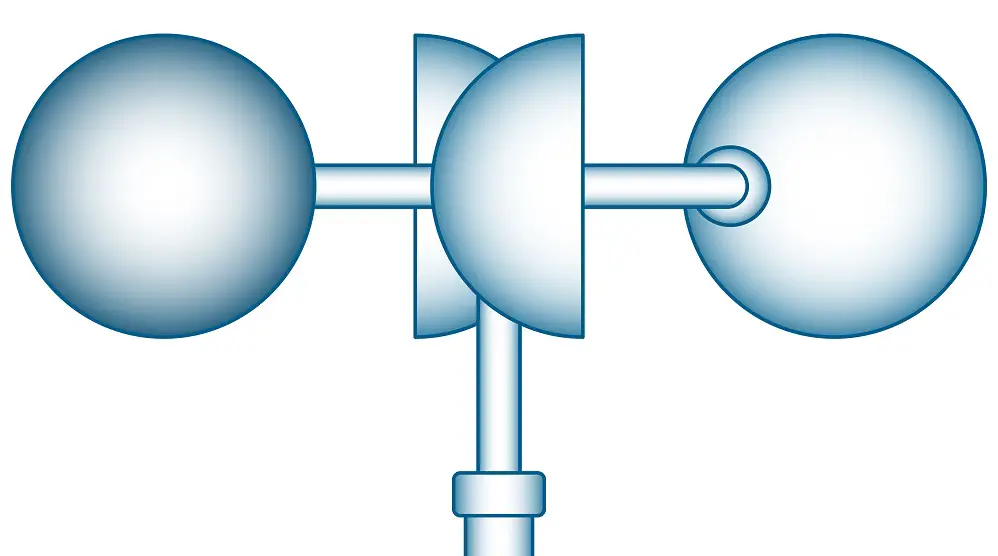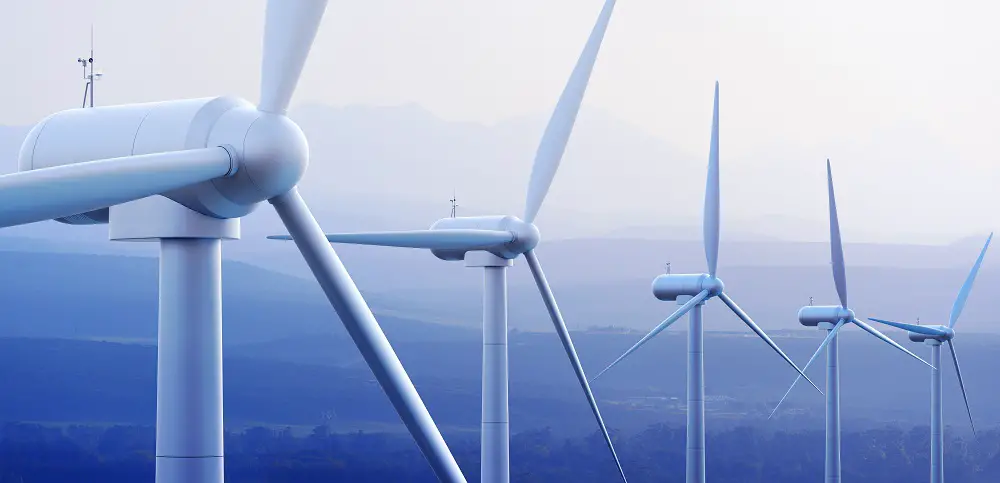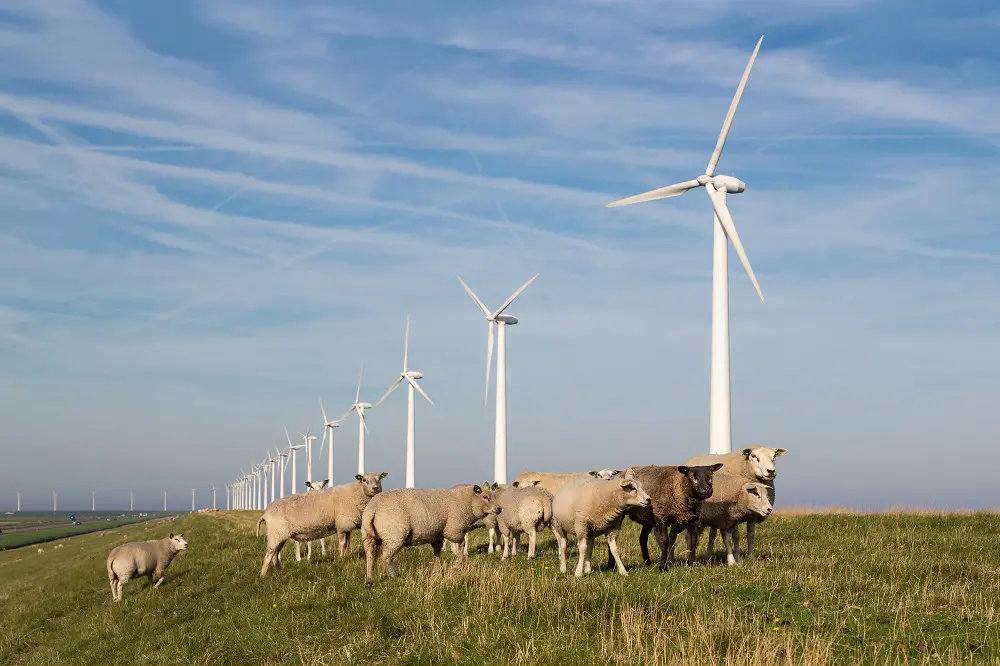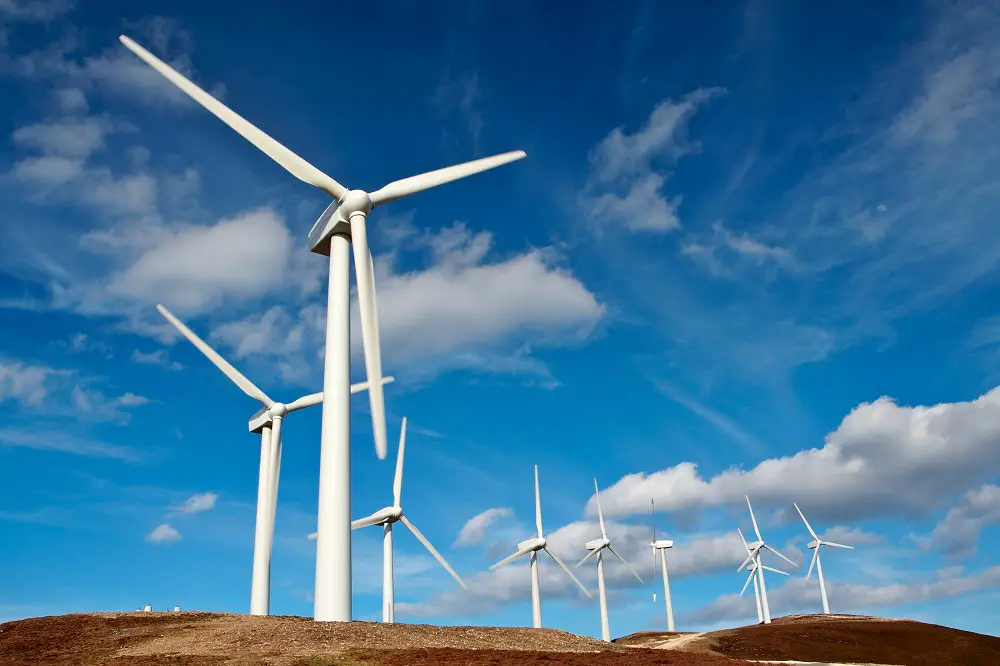Regular turbines comfortably achieve speeds of 100mph, larger styles with heavier blades, reach speeds of 180mph.
The speed at which the blades of a wind turbine spin is in direct relation to the velocity of the wind. Wind turbines are most efficient when the the wind speed is high.
Although it may look like a series of wind turbines move at a constant speed, they don’t.
However, finding the ideal position to place wind turbines takes months of exacting testing. They are placed in regions where the wind speeds are the most constant and consistent year-round.
What Makes the Blades of a Wind Turbine Rotate
There are 3 main parts to a wind turbine:
- Blades
- Rotor
- Turbine
Wind turbines extract energy from the wind. Automatic orientation created by the nacelle situated at the top of the tower is positioned to take maximum advantage of the wind, regardless of which direction it is blowing.
As wind passes by, the aerodynamic, giant blades spin. This is only achieved when the wind reaches cut-in speed; the minimum strength of wind required to move the blades is between 6-10 mph.
The blades are attached to a rotor, 3 blades in a hub, that spins a shaft connected to a gearbox. This increases the turning velocity from 13-20 rpm to 1500 – 1800 rpm.
The gearbox transfers the energy through a fast shaft to a generator. It is here that the energy receives added voltage and the electricity is distributed from substations to the National Grid.
How is Turbine Speed Calculated
From a distance, it is easy to be fooled into thinking that wind turbines spin in a slow and cumbersome manner.
It is not until you get up close to them that you appreciate the speed at which they rotate.
When you know the formula, it is possible to calculate the speed of a turbine, with the help of a calculator.
You will need to know the length of the blade and the traveling circumference the tip of the blade takes in a single revolution. This is done using the equation 2∏r (twice the radius multiplied by pi, 3.1415)
Therefore, a blade measuring 120ft. X 2 = 240ft.
Multiply this by pi, equalling 753.96ft. This is the circumference of the turning circle.
If it takes 4-seconds for the blade tip to travel that distance, in feet per second the speed is
753.96 / 4 = 188.49ft/sec
To convert this to mph it should be multiplied by 0.681818182.
This particular wind turbine turns at 128.5mph.
This is relatively slow as large turbines can achieve speeds of 180mph before cut-out methods react.
The Maximum Speed of a Horizontal Axis Wind Turbine
All turbines are designed to operate to maximum speed, with maximum efficiency. Known as the RATED SPEED, or SURVIVAL SPEED, once severe storms hit and the wind speed breeches safe limits, the turbine needs a fail-safe to protect damage to the blades or the motor.
Safe wind speed ranges are considered to be:
40 meters per second (144 km/h, 89 mph)
to
72 meters per second (259 km/h, 161 mph)
The most common recommended Survival Speed is 60 meters per second (216 km/h, 134 mph).
What Happens When the Wind speed Exceeds Survival Speed?
Increased wind speeds generate more electricity until the turbine is operating at maximum rated power. However, to generate maximum power efficiently, the rotation speed of the blades should be controlled.
To prevent damage to the blades and unnecessary strain on the motor, the turbine has two methods of reducing torque in high winds.
- Automatic cut-off: When the wind speed registers the Survival Speed, the auto-shutdown of the motor is triggered, causing the rotors to cease.
- Feather blades: Fitted to the outer edge of a blade during construction, the feathers help to reduce unwanted rotational torque. When the wind speed reduces, they ‘unfeather’ and resume normal operation.
How Wind Speeds are Measured

Wind turbines employ the use of a vane anemometer, a piece of equipment essential to their safe and controlled operation.
The machine is situated atop the tower, easily recognized by the set of spinning blades or cups. The number of revolutions over an allotted period is measured and displayed as MPH or Km/H.
The vane denotes the other important factor, wind direction.
Tip Speed Ratio (TSR)
TSR is the formula employed by designers to ensure their turbines capture enough viable air.
It is the ratio between the rotational speed of the tip of the blade and the actual velocity of the wind.
For example, blades traveling at 100mph with a wind speed of 20mph results in a TSR 5, 100/20 = 5.
Therefore, the tip of the blade is traveling 5 times faster than the wind.
Highly efficient, 3-blade wind turbines usually have a TSR 6-7.
Although a higher ratio is desirable, it shouldn’t be to the detriment of the motor. Should it become over-stressed it will become noisy and possibly fail.
The TSR of a wind turbine is particularly important to measure its efficiency and capability of producing maximum energy.
A low ratio where blades move too slowly means too much wind bypasses the blades and is wasted.
A high ratio where blades move too fast means they are passing through the turbulence of the previous blade. This second-rate wind decreases efficiency.
Factors that Influence Wind Turbine Speed
Although it might seem most viable to position wind turbines in regions where the wind speeds are highest, this isn’t necessarily the case.
Turbines produce the greatest amount of renewable energy when placed in areas with regular constant wind, rather than occasional high winds.
Power output is influenced by other elements:
Wind Power
Stronger winds provide most power conversion as they rotate the blades faster.
Air Density
The air density of a particular locale is a combination of altitude, pressure, and temperature. Denser air applies more pressure to rotors resulting in higher power output.
Blade Radius
Larger blades have a greater surface area enabling them to capture more of the wind’s kinetic energy.
Bigger blades need higher winds to set them in motion and require more space.




